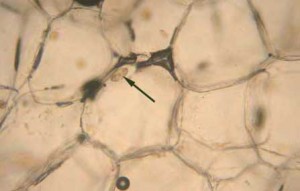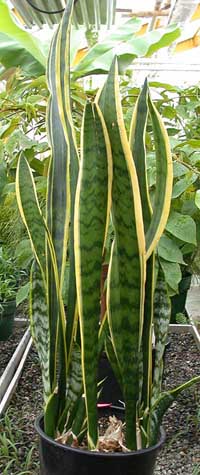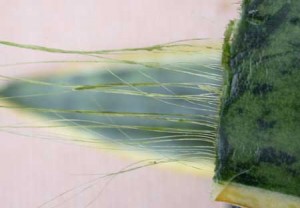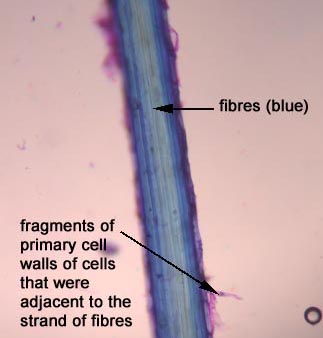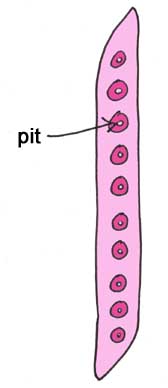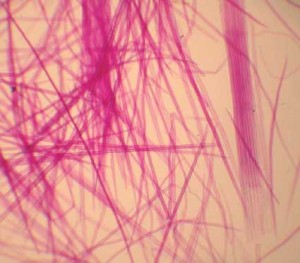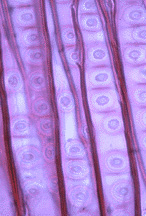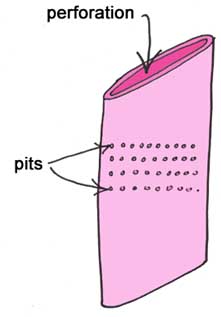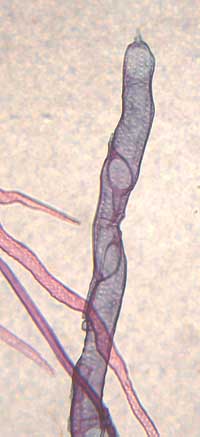In this section we will examine the components of cells, while paying particular attention to those features that confer qualities of interest to humans. For example, wood is primarily made up of cells that are thick-walled and dead. A function of these cells is to provide strength and support for the plant; these qualities of wood make it an ideal material for construction. Other cells of a plant may have a storage function which can serve an important food and energy source for humans. We will begin this section by looking at the general structure of a plant cell followed by introducing cell variation.
Generalized Plant Cell
| The cell is the basic building block of all organisms. Illustrated below is a cell labeled with some of the cellular components. For purposes of this course we will concentrate on a limited number of features. |
Cell Membrane (plasma membrane or plasmalemma) – a membrane enclosing the cytoplasm of a cell. The cell wall is outside of the cell membrane.
Contents of the cell:
(i) nucleus – membrane-bound structure containing the chromosomes of a cell (genetic material). The nucleus is important in controlling the activities of the cell and the traits of an organism.
(ii) chloroplasts – organelle that contains photosynthetic pigments (chlorophyll).
There are a number of other plastids that can be present in a plant cell. These are often important for storage (e.g. starch in amyloplasts, carotenoid pigments in chromoplasts).
(iii) vacuole – membrane-bound cavity within a cell in which various water soluble compounds are stored. Crystals of calcium carbonate or calcium carbonate are commonly found in vacuoles. They are sharp and deter herbivores. In many cases toxic chemicals are sequestered in the vacuoles (nicotine, tannic acids). Water soluble pigments, such as anthocycanins are stored in vacuoles. Anthocyanins are responsible for most of red and blue colouration you find in plants. The contents of the vacuole is called cell sap. In some cases it is very acidic and responsible for the tartness of fruits such as oranges and lemons.
(iv) mitochondria – organelle in which respiration occurs (conversion of carbohydrates into energy).
Cell Wall Composition
The cell wall is important for the plant providing rigidity and form. It is often thought of as inert. This is not very realistic; chemical reactions go on within the matrix of the cell wall. It must accomodate for cell growth as well as allow the passage of water and other important chemicals. The cell wall is made up of a number of components.
(i) cellulose – long polymer of glucose molecules. Cellulose is the most abundant organic molecule. Cotton fibres are almost 100% cellulose, whereas wood is approximately 50% cellulose. It is not digestible by most organisms, including humans, and so passes through as “roughage”; cellulose is a major source of dietary fibre.
(ii) pectin – gel-forming polysaccharides which glue cells together. It is also common in first-formed layers of the cell wall. Layers formed later may lack pectins.
(iii) hemicellulose – cellulose-like polysaccharides which are more soluble and amorphous than cellulose. They form cross-links between the long microfibrils of cellulose within the cell wall.
(iv) lignin – a very tough polymer formed from three different types of phenolic acids. Once a cell becomes lignified it can no longer grow and the cell wall becomes impermeable to water. Generally a lignified cell is dead at functional maturity.
Dietary fibre is derived from the cell wall components of plants. There are two categories: insoluble fibre (also called roughage) and soluble fibre. Insoluble fibre is made up of cellulose, hemicelluloses, and lignin. Soluble fibre (such as pectin) is hydrophilic and forms a gel. Soluble fibre is commonly found in fruits and vgetables. Apples for instance have lots of pectin. Because of its gelling nature pectins are used to make jams and jellies.
Cell Types
Variaton of cellular components results in the many different cell types that make up a plant. The variety of cell types relfects the different functions performed by different cells. When considering function, the microscope is an important tool in examining plant cells and tissues.
Things to consider when determining the cell type:
– thin-walled vs thick-walled
– alive or dead at functional maturity
– pigmentation
– storage products
– secretory function
Examples of cell types::
Here are a few examples of cell types. Keep in mind that this is not a comprehensive list.
| (i) parenchyma – this cell type is variable depending on function. Parenchyma cells are usually more or less round. They often have a thin cell wall that is not lignified. This is important if the cell needs to grow or divide since even tje plant cannot degrade lignin. Consequently, once there is lignin in the cell wall the cell cannot be modified in shape or size. Parenchyma cells of onion is pictured to the right. |
| (ii) fibre – this cell type is important in that it provides support. The cells are elongate with a very thick cell wall. In fact the lumen of the cell is very narrow; the vast majority of the cell is cell wall material. The cell wall is most commonly lignified. Lignin is one of the most abundant chemicals on the planet. It gives strength, impermeability, and decay resistance to the tissues in which you find it. People have many uses for fibres. The picture below shows isolated fibre cells. |
| Sanseveiria (mother-in-law’s tongue) has long leaves which have been used as sources of fibre in the past. |
| The fibres of a number species of Sanseveiria are used for their fibres. In the picture below you can see the fibres when the leaf is broken and partially peeled. |
| In the picture to the right, an isolated “fibre” is stained with toluidine blue. The word fibre in the textile industry refers to a number of fibre cells clustered together to form a strong unit. |
| In the leaf cross-section (stained with toluidine blue) you can see the clusters of fibres with their thick secondary cells wall (stained blue). |
Extra Information: Fibres to Textiles
(iii) tracheary element – these are the main water-conducting cells of a plant. The tracheary elements are dead at functional maturity. They have a wide lumen (space inside cell wall) which accomodates for the conduction of water. The cell walls are lignified which not only adds strength to the cells, but also facilitates the movement water (kind of like up a straw). The tracheary elements often have pits which are not holes, but rather thin areas of the cell wall which are thin and unlignified. Water can pass through these parts of the cell walls.
There are two kinds of tracheary element: tracheids and vessel elements.
| Tracheids are more primitive. These elements are elongate and have many pits which allow water movement. |
| Figure 2(i) below is a picture of the macerated wood of pine (cells are separated using enzymes). You can see the elongate nature of the tracheids. |
| The longitudinal sections show the long tapered nature as well as the large circular pits common to the tracheids of conifers. |
| Vessel elements are another type of tracheary element. They are similar to tracheids, but the lumen is generally wider and they have perforations (in addition to pits). Perforations are holes in the cell wall. |
| The perforations of vessel elements are generally restricted to the end walls of the cell. Vessel refers to a number of vessel elements attached end-to-end to form a tube. The following images demonstrate how vessel elements are attached to each other to form a long tube (=vessel); the perforation of one cell is lined up with the perforation of the next, facilitating the movement of a steady stream of water through the vessel. |
In summary, what features of a cell are going to give you clues about the function of that cell?
Look at the cell wall:
– is it thin or thick? – if the cell wall is thick then you can assume that it will have a support or a protective function.
– what is the chemistry of the cell wall? – if lignin is present the cell will have a different function than a cell that is non-lignified.
Look at the cell contents:
– are storage products present?
– is the cell photosynthetic?
Remember, we have only discussed a few cell types; there are many more. For additional information go to the resource page for this section and explore the website postings.
In the next section you will see how the cells are put together to make tissues.


